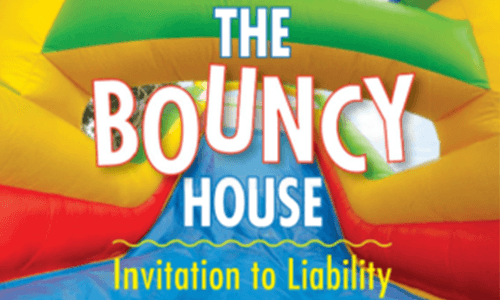Residents in community associations often behave as if they still reside in single family homes. They tend to forget that liability exposures created through their personal activities will affect others. A perfect example is when a unit owner asks permission from the property manager or board of directors to rent a bouncy house for their child’s birthday party or similar event.
The bouncy house, also known as a moonwalk, is an inflatable device rented from a local firm. Similar devices include wet ‘n’ wild slides, dry slides, obstacle courses and interactive games. Sometimes several devices can be ordered. The dimensions are often 15’ X 15′. The rental is typically 4 hours at a cost of $200 to $450. Sounds like fun, doesn’t it?
The bouncy house rentals do come with recommended weight limits for the children using it. For example, a 15′ X 15′ inflatable comes with recommendations of no more than 10 kids ages 8 and under, 7 children ages 9 to 12, a maximum of 5 teens, or 3 adults.
Liability exposures arise when a unit owner wishes to set up a bouncy house on common elements. A main question concerns who is going to supervise the use of the bouncy house and limit the number of jumping kids to the recommended number. The exposure is compounded when teens are jumping alongside youngsters under the age of 8. Obviously, a 150-pound teenager colliding with a 50-pound 6 year old could cause some serious harm. Any resulting injuries from the bouncy house operation now become a potential liability claim against the community association. Consider that many of the jumpers are invited guests, and their parents may or may not be residents of the community association. In other words, if their small child is injured in the bouncy house, those guest parents will have no reservations about seeking financial recovery from the unit owner who rented the bouncy house, as well as the association for allowing the inflatable device to be set up on the common elements. Bodily injury claims involving youngsters have the added issue of how the injury may affect the child’s development.
One remedy for the property manager and board of directors is to require evidence of homeowners insurance from the unit owner sponsoring the event. A standard limi
t for Personal Liability (Coverage E) in a homeowner’s policy starts at $100,000. For a nominal premium this Coverage E limit can be increased to $300,000 or $500,000. The board of directors could create a rule for bouncy house renters to show evidence of homeowners insurance with a certain minimum limit, like $500,000.
Another option is to require the bouncy house renter to ask their homeowner’s insurer to add the community association as additional insured for liability stemming from the bouncy house rental. This sounds reasonable but it is not always practicable. Consider that there are several thousand property casualty insurers offering homeowners insurance in the United States. Some of these carriers will be willing to extend coverage to the association, which usually results in an additional insurance premium. Other insurers will not offer this extension of coverage. Now what do you do when the insurer will not offer this additional insured status to the association?
The association’s legal counsel should be consulted to craft an agreement to hold the association harmless for ensuing injuries from use of the bouncy house. The agreement should also contain a provision for the unit owner to indemnify the association if the association makes any payment for injuries due to a settlement or court verdict.
If this all sounds like a hassle for the potential renter of the bouncy house, it definitely is. The property manager or board of directors should recommend that the resident consider going to some off-premises venue with inflatable moonwalks and slides which specializes in hosting birthday parties. This alternative does not impose any potential liability on the community association, and there is certainly less stress for the manager and Board. When you receive the invitation to the bouncy house, always carefully consider the invitation to liability that comes with it!




 Lea Marcou
Lea Marcou 
 CAI - Illinois Chapter
CAI - Illinois Chapter 


